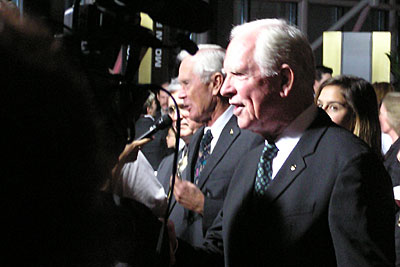Magnificent opportunity missedby Tom Hill
|
| Most appear perfectly happy to allow space efforts to continue at their current level of public funding while a small minority work for the time that many can fly into space, and cheer others working to make that happen. |
Overall, few people are aware that another major event related to lunar exploration happened last week. On Friday, the 23rd of September, a movie about the Moon was released. Although it appears to celebrate the past rather than focusing to the future (I haven’t seen it yet), Magnificent Desolation, with its 3-D IMAX images of recreated moonwalks, is receiving excellent reviews from those who have seen it (see “Review: Magnificent Desolation”, this issue).
Even fewer people are aware that a reception and private showing of Magnificent Desolation was held at a museum in downtown Washington on Wednesday night, the 21st of September. The company who partially funded production of the movie sponsored the event with attendees that ran the gamut of the famous in science and space, including five prior moonwalkers, current astronauts, NASA brass, and entertainers related to the movie’s production.
I believe that this event had potential to be a major crowd pleaser… if it had been widely advertised. I believe that at least hundreds of people would be interested in seeing the heavy-hitting attendees. In a Hollywood-style approach, they could have pulled up to the museum and walked up to the entrance with well-wishers on both sides. After entering, things could have happened exactly the way they did in actuality, with an indoor red carpet and media doing short interviews with the attendees.
So, the decision boils down to this: are the members of the collective space effort satisfied with their place in society, or do they want to risk taking on a higher profile? It’s true that NASA has become more media savvy in recent years, but the media environment has changed so much in parallel that the agency’s improvements have barely changed its profile in daily life. Sports coverage, for example, has expanded to include multiple full-time cable channels and pay-per-view games, while Hollywood continues to draw the public’s eye with parties and news shows devoted to covering those events. Can a space effort learn something from these changes?
| It’s likely that the core reason a large public and media event didn’t happen was much simpler: no one thought of it. |
There are many reasons that the major players involved may have chosen to avoid a big, visible, public event. Large companies on government contracts typically don’t like to draw a lot of attention when they’re throwing a party, yet their corporate logo appears at the beginning of most space-related IMAX movies. The museum, providing the venue, likely had little to do with planning the event itself, and NASA personnel, as civil servants, typically don’t think of themselves as a “glitz and glamour” commodity. Perhaps a huge gala event, if it were planned, would have to be toned down in light of Hurricanes Katrina and Rita, but a toned-down event could still take place and draw some attention; especially in light of the recent return-to-the-Moon announcement.
It’s likely that the core reason a large public and media event didn’t happen was much simpler: no one thought of it. People who work in the space industry may have accepted their role in society, working on their missions in relative obscurity, aware that some day when their work could be front-page news, and striving to keep that news positive. For many workers, “frivolous” events like movie openings are a welcome distraction from the grind, a chance to meet greats of the past and present and see a previous project brought to larger-than-life form. In other cases, people working on the same projects will consider such an event an annoyance-they grin their way through it as part of their job, awaiting the chance to get back to “real work.”
Admittedly, some of this essay is based on a personal disappointment. I’ve never attended a Hollywood premiere, but I was willing to bring my wife, five-year-old son, and one-year-old daughter into town just for the opportunity to point at someone and say, “He walked on the Moon!” and to hear my son say “Wow!” A large percentage of the people in the metro-DC area do not share that interest, but it only takes a small percentage of the millions living in the vicinity to make a good crowd. I believe that a different layout of the Wednesday night event could have made it memorable for many more people, and memorable events, made personal to members of the public, are an important part of any publicly-sponsored effort.
